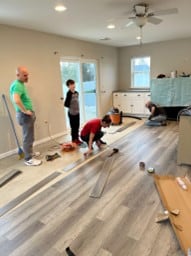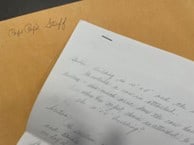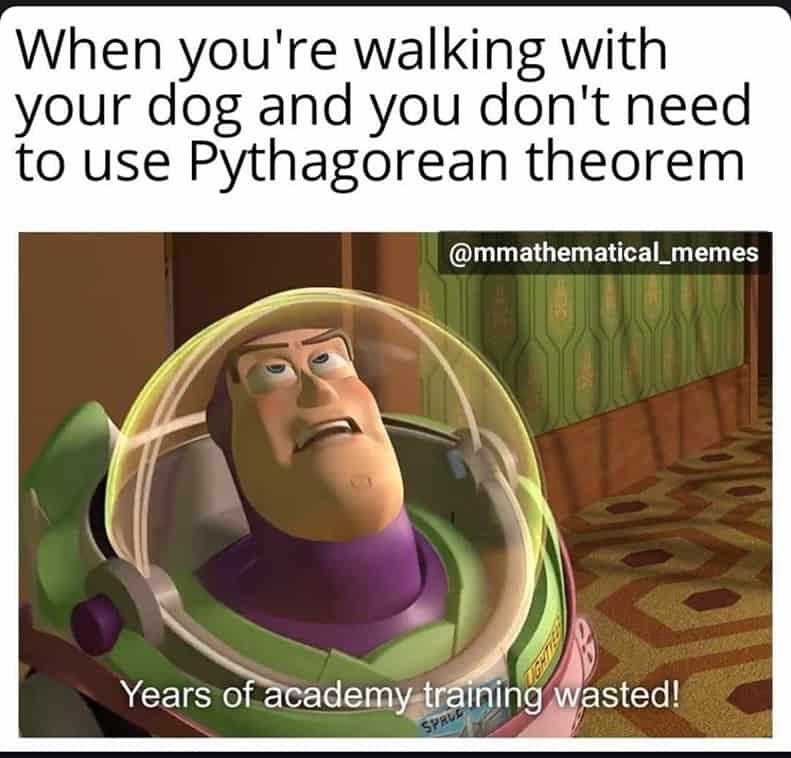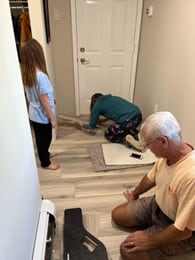Chelsey Staub – Social Studies Teacher
I use math in my everyday life, not just because I grade assignments and help students in our online schooling environment here at 21st Century Cyber Charter. From the time I was born, math has been ever-present in school and my everyday life.
I grew up in a house that was over 200 years old. My parents still live there. As a result, my childhood was filled with projects and renovations. Anytime there would be a break in the school year, we would dismantle a bathroom or prepare the house for a major addition. There are pictures of me in an infant carrier with construction going on behind me. My family is fairly handy. One of my grandfathers enjoyed woodworking and building. My other grandfather was an engineer so I have both the knowledge of construction and actual application in my background. Math is crucial in building and renovation, which I will delve into more later.
My grandfather who enjoyed woodworking died when I was in 1st grade so I didn’t get to learn directly from him about building, but I did learn it via my father who is his son. I spent a lot of time with my grandfather, who was an engineer, and I idolized him. I would sit in my grandparents’ peachy orange and brown kitchen as an elementary school-aged child and he would bring out his manila folder of math puzzles for me to solve. Many of them were way above my head at the time. Problems like “Given: A building is 10’ x 5’ and the chain is 20’ long to which a cow is attached. Problem: How much area does the cow have access to graze in when his 20-foot chain is attached to one corner of the 10’ x 5’ building?” I recall asking him to help me with some homework in 5th grade, and after he helped me with the problem, he started telling me how this would later be a building block to calculus. I had to stop him and say “Pop-pop, I don’t think I’m there yet.” He unfortunately passed before he could help me with calculus, but I learned a lot from him before that time, and I’d like to think he passed some of his traits onto me. I did have his books to help me and his metal box of math/engineering index cards. I even have his manila folder with all the math puzzles.
This gives you some background about why math is a big part of my life. It also helps you see how I was always taught about math, both in the academic sense in school and in the applied sense, primarily through my grandfathers and father.
I am certified to teach Social Studies, Math, and English. When I first started teaching at a different school, I was teaching Social Studies, but my students would come in during lunch or study hall and have me help them with their math. I used to joke with one of my students that she was getting so great at math that she would one day be a math teacher. She later became a preschool teacher, so I was partially correct. As with at that school, I’m often my family’s go-to for math questions.
My brother has even called me recently to ask about the Pythagorean theorem. This may sound strange, since you may have seen memes poking fun of learning things like the Pythagorean Theorem by facetiously saying they have really come in handy in adulthood. Sometimes, it can be helpful when you least expect it. My brother was remodeling his kitchen and was trying to figure out where to place his island. He needed a certain amount of clearance between the island and the stairs diagonally and had two other measurements off of the cabinets across from the island and to the wall. Pythagorean Theorem (a^2 + b^2 = c^2) was the easiest way to find it.
I use math often while remodeling, too. The current house I live in with my husband, son, and daughter has already had 2 additions and countless renovations. I think because of my upbringing, I’m used to looking at houses and determining how to change them to make them more workable for the family living in it. I have drawn up rough sketches of what our additions would look like, making sure to use correct measurements so we knew if it was possible to proceed with whatever renovation or addition. When we first moved in, we were renovating the kitchen, and I happened to find brand-new cabinets for sale on an online marketplace. This helped with our budget at the time, but I also needed to be sure the configurations would work in our kitchen.
I used problem-solving that I honed in my math classes (thanks largely to solving proofs) to find creative ways to complete renovations we wanted or needed to complete within our budget and with whatever resources I could find. My mom has helped me paint countless rooms, and I needed math to figure out how much paint to buy based on the surface area of the walls we were painting. I have laid new vinyl plank floors in our home and again, budgeting came into play as well as the area of the room. Measurements are of course, used while laying the floor as well. My father, brother, and I often work together, someone measures and cuts while someone else lays the planks. We also need to use division to decide if we should start with a whole plank or not. You can’t finish with a small sliver against the wall so you need to be sure it will be a wide enough plank by the end. You decide this by measuring the width of the room and dividing it by the width of the planks.
When I told my mom I would be writing this blog, she reminded me of other ways I use math in my daily life. Math is not my mom’s strongest skill – as she will tell you. She is a wonderful cook and hosts a family dinner for my family and my brother’s family each Tuesday. She often calls and asks me to double or triple the measurements in recipes. My mom is much more skilled at sewing than I am, but we both sew and use math to figure out how much material we need for a project, and we use it while sewing the project as well. As an example, I have made winter hats for my children a few times using fleece. I measure their heads first and then need to account for a seam allowance and add inches to the bottom to allow for a wider turned up band.
I’ve mentioned budgeting a few times already, but this one is important and I use it weekly when I go food shopping for the week. I have a running estimate as I shop of what my total bill will be – adding each item as I add it to the cart. My husband and I use math to figure out tips at restaurants – although I know some receipts now tell you the values for typical tip amounts, but for a long time that was not available to us. In our marriage, my husband does most of our banking and bill paying, but that is another way math is absolutely applied to our daily lives. When we bought our house, we searched for the right mortgage that could be comfortably paid each month and paid off in total as quickly as possible. Knowledge of interest rates are key when looking for a mortgage that fits best.
Math also comes in handy when my own children who are 9 and 11, need help studying or with their homework. I have tried to instill a love of learning in them as well. When they were little, you’d be surprised at the division they were able to perform quickly when they saw mini muffins come out of the oven and wanted to know how many they could have if we divided them equally. Just this weekend, we got takeout from a local Italian restaurant, and it came with 6 cannolis. My daughter asked how many we could each have and then said, “Oh right, one and a half.“
I love math and would be likely to try to find ways to use it in my daily life regardless, but most of what I use math for each day just happens naturally. I enjoy working with students to help them learn important principles of math. 21st Century Cyber Charter provides me with a fantastic opportunity to individually help many students with math. I don’t foresee everyone having friends who send them cool math videos or discussing box and whisker plots during book club (these both happen in my life – honestly). I understand my love of math is somewhat unique, but I do hope students will be able to take portions of what they learn here in school and apply those aspects to their daily lives in useful ways, as I often do.





